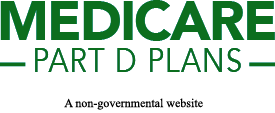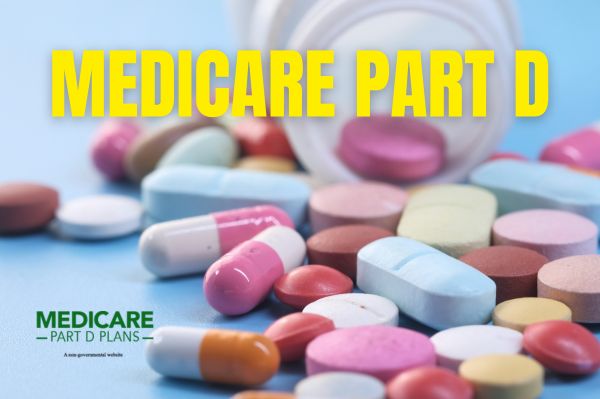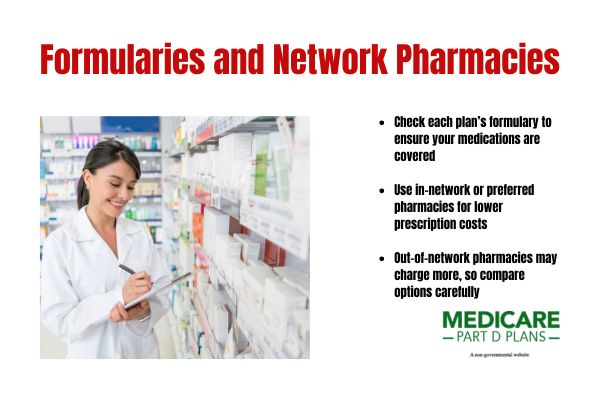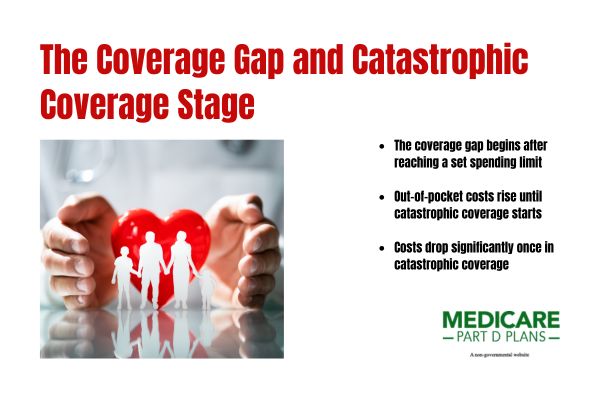Find a Medicare Part D prescription drug plan

Medicare Part D
Prescription Drug Coverage 2026
Medicare Part D Plan Comparison
Choosing the right Medicare Part D plan will likely be essential for optimal prescription drug coverage. This article provides a straightforward Medicare Part D plan comparison, focusing on possible costs, formularies, and pharmacy networks to help you make an informed decision.
Key Takeaways
- Medicare Part D provides essential prescription drug coverage through private insurance companies, likely offering Standalone Prescription Drug Plans (PDPs) and Medicare Advantage Prescription Drug plans (MA-PDs).
- Possible factors for comparing Medicare Part D plans might include premiums, deductibles, copayments, formularies, and preferred pharmacies, which could help determine the best coverage for individual needs.
- Utilizing tools like the Plan Finder on this website and talking to one of our licensed agents can streamline the process of selecting suitable Medicare Part D plans.
Understanding Medicare Part D in 2026
Medicare Part D may be a vital component of the Medicare program, likely providing essential prescription drug coverage to help beneficiaries manage their healthcare costs.
The primary goal of Medicare Part D will likely be to ensure that individuals have access to necessary prescription medications, which could significantly impact their overall health and well-being. This coverage may be particularly important for those who rely on medications to manage chronic conditions or serious illnesses.
Medicare Part D will likely be offered by private insurance companies that are approved by Medicare. Medicare might offer two primary options for prescription drug coverage: Standalone Medicare Prescription Drug Plans (PDPs) and Medicare Advantage Prescription Drug plans (MA-PDs). PDPs will likely operate in conjunction with Original Medicare, specifically Parts A and B.
On the other hand, some MA-PDs might merge drug coverage with additional healthcare benefits that may be offered through a Medicare Advantage plan. Even if you don’t currently take prescription drugs, enrolling in a Medicare Part D plan could help you avoid higher premiums later.
Elements of Medicare Part D Plans
Medicare Part D plans will likely be designed to provide prescription drug coverage for individuals enrolled in Medicare. Offered by private insurance companies approved by Medicare, these plans will likely cover both brand name drugs and generic drug medications.
Understanding the different types of plans, the cost structure, and the importance of formularies and network pharmacies could help you navigate the options and select the plan that best meets your needs.
Types of Medicare Part D Plans
Medicare Part D may provide two plan options: Standalone Prescription Drug Plans (PDPs) and Medicare Advantage Prescription Drug Plans (MA-PDs). PDPs work alongside Original Medicare (Parts A and B) and may only provide drug coverage. On the other hand, some MA-PDs might combine drug coverage with additional healthcare benefits under a Medicare Advantage plan.
The main difference between these two types might be that PDPs focus solely on prescription drugs, while MA-PDs could offer a more comprehensive approach by potentially offering other healthcare services.
Choosing between PDPs and MA-PDs will likely depend on your individual healthcare needs and preferences.
If you prefer to keep your drug coverage separate from your other healthcare benefits, a PDP might be the right choice. However, if you’re looking for an all-in-one plan that could cover more aspects of your healthcare, an MA-PD may be more suitable.
Cost Structure and Coverage Levels
The cost structure of Medicare Part D plans will likely include several elements:
- Premiums: Monthly premiums may vary based on the specific plan chosen and may increase with income.
- Deductibles
- Copayments
- Coinsurance
After reaching the deductible, beneficiaries might pay up to 25% of the costs for medications during the initial coverage stage. Comparing these costs across different plans could help determine which plans might offer the best coverage for your needs and budget.
Understanding the cost-sharing structure, such as copayments and coinsurance, will likely be crucial for managing out-of-pocket expenses under Part D plans.
Formularies and Network Pharmacies
Each Medicare Part D plan maintains a specific medication formulary, which lists the prescription drugs that may be covered by the plan. Before enrolling, members should verify that the plan’s formulary aligns with their medication needs. Reviewing the plan’s formulary could help to confirm that your necessary medications may be included and identify any potential restrictions.
Access to medications through Part D plans will likely be contingent on using pharmacies within the plan’s designated network. Important points to consider might include:
- Preferred pharmacies may sometimes offer greater savings on prescription costs.
- It’s important to check whether your preferred pharmacy is in-network.
- Using out-of-network pharmacies might result in higher costs.
Comparing prescriptions coverage options could potentially ensure you have access to the medications you need at the most affordable cost.
Possible Factors to Consider When Comparing Plans
When comparing Medicare Part D plans, several factors may come into play to help ensure you select the best option for your needs. These might include:
- Your current prescription medications
- Premiums
- Deductibles
- Copayments
- The coverage gap
- Preferred pharmacies
Effective plan comparison will likely help you select the best coverage at the most affordable cost.
Current Prescription Medications
Before enrolling in a Medicare Part D plan, follow these steps:
- List your current prescription medications. This step could help ensure you choose the right coverage for your needs.
- Use this list to identify which plans may cover the specific drugs you need.
- Use the Plan Finder tool on this website to enter your medications and find plans that cover them, providing customized results based on your medication needs.
Using this website can help ensure that you choose a plan that aligns with your prescription drug requirements.
Premiums, Deductibles, and Copayments
Potential cost elements in Medicare Part D plans may include:
- Monthly premiums
- Annual deductibles
- Copayments
- Coinsurance
Different plans might have varied premium rates, which could significantly affect your total costs. For effective budgeting, members should consider both monthly premiums and out-of-pocket costs.
Annual deductibles may also vary widely between plans, likely impacting your initial out-of-pocket expenses. Understanding the cost-sharing structure, such as copayments and copays, could help manage out-of-pocket expenses under Part D plans.
The Coverage Gap and Catastrophic Coverage Stage
Medicare beneficiaries enter the coverage gap, also known as the donut hole, after reaching a specified spending limit. During this phase:
- Out-of-pocket expenses may increase
- This will likely continue until reaching the catastrophic coverage stage
- At the catastrophic coverage stage, costs may significantly decrease
Knowing these stages will likely help to manage potential out-of-pocket money expenses that are paid.
Preferred Pharmacies and Mail-Order Options
Using preferred pharmacies could potentially lower out-of-pocket prescription costs significantly. Not all plans feature the same preferred pharmacy networks, which may lead to different out-of-pocket costs. Mail-order options may also provide convenience and might offer lower prices for regular medications.
Mail-order pharmacies may reduce costs for those who take maintenance medications regularly. The Plan Finder tool on this website may also provide tailored plan recommendations based on user input regarding medications and preferred pharmacies.
Tools and Resources for Plan Comparison
Several tools and resources are available to assist in comparing Medicare Part D plans. These resources help you evaluate multiple plans side by side, making the comparison process easier and more effective.
This Website
By entering your zip code into the Plan Finder Tool on this website, members can compare Medicare Part D plans. It offers the following features:
- Assists in assessing plan options and costs to find the best fit for users
- Allows users to filter results according to specific health needs and preferences
Some Medicare Part D plans may offer mail-order options for convenient medication delivery.
Assistance from Licensed Agents
Calling one of our licensed agents can play a crucial role in helping beneficiaries understand and choose the best Medicare Part D plans. They provide personalized guidance and assistance to match individual needs with suitable plans. Their expertise allows them to navigate the complexities of Medicare Part D options effectively.
By calling the number on this website, members can ensure they choose the best plan for their prescription medications.
Reviewing Plan Documents
Reviewing plan documents and summaries of benefits for Medicare Part D plans will likely provide detailed information about coverage, cost-sharing, and network pharmacies. Reviewing these documents could help ensure you understand the specific coverage options available and any associated costs or possible limitations.
Carefully examining plan documents may help uncover potential out-of-pocket costs and potential limitations on coverage, ensuring you make an informed decision.
See plans in your area instantly!
Advertisement
Steps to Compare Medicare Part D Plans
To effectively compare Medicare Part D plans, follow these steps:
- List your current medications to verify coverage under potential plans.
- Use this website to compare monthly premiums, annual deductibles, and copayments for effective budgeting.
- Understand the coverage gap and catastrophic coverage stage to manage out-of-pocket costs.
Review plan documents and summaries of benefits to understand coverage details and plan details and terms before enrolling. By following these steps, you will likely be able to determine which plan could offer the best coverage for your needs.
Enrolling in a Medicare Part D Plan
Enrolling in a Medicare Part D plan likely ensures your prescription drug coverage aligns with your healthcare professional needs.
Considering various enrollment periods is important when signing up for Part D coverage. Specific circumstances should also be considered to determine if you are eligible.
Annual Enrollment Period
The Annual Enrollment Period for Medicare Part D occurs from October 15 to December 7. During this time, beneficiaries can switch, drop, or enroll in new Medicare Part D plans.
Changes made during the Annual Enrollment Period become effective on January 1 of the following year.
Initial Enrollment Period
The Initial Enrollment Period for Medicare Part D occurs around the 65th birthday, lasting seven months. It starts three months before turning 65 and continues until three months after.
Coverage start dates may vary based on when enrollment occurs during the Initial Enrollment Period.
Special Enrollment Periods
A Special Enrollment Period (SEP) for Medicare Part D is a period allowing enrollment or changes outside regular enrollment times due to specific life events. Knowing these enrollment periods helps avoid late enrollment penalties and coverage gaps.
Specific life events or situations can trigger a Special Enrollment Period.
Find a Plan and Enroll Online Yourself!
Advertisement
Summary
Navigating Medicare Part D might be complex, but understanding the various factors comparing plans can make the process more manageable. By listing your current medications, comparing the potential premiums, deductibles, and copayments, and using this website, you can find a plan that meets your needs and budget.
Remember, enrolling during the appropriate periods and seeking assistance from our licensed agents can help you avoid penalties and ensure you get the best coverage. Choosing the right Medicare Part D plan will likely be essential for managing your healthcare costs and maintaining your overall health.
Frequently Asked Questions
What are the two main types of Medicare Part D plans?
The two main types of Medicare Part D plans are Standalone Prescription Drug Plans (PDPs) and Medicare Advantage Prescription Drug Plans (MA-PDs). Choosing the right one will likely depend on your specific healthcare needs and preferences.
How can I find a Medicare Part D plan that covers my medications?
To find a Medicare Part D plan that covers your medications, utilize the Plan Finder tool on this website, where you can input your medications and identify suitable plans.
What is the coverage gap in Medicare Part D?
The coverage gap, or donut hole, in Medicare Part D is a period where beneficiaries might experience higher out-of-pocket drug costs until they reach catastrophic coverage, which could potentially reduce their expenses. It’s important to be aware of this phase to manage your prescription drug costs effectively.
When is the Annual Enrollment Period for Medicare Part D?
The Annual Enrollment Period for Medicare Part D is from October 15 to December 7, allowing beneficiaries to make changes to their plans. This is the time to ensure your coverage meets your needs for the upcoming year.
Why is it important to review plan documents before enrolling in a Medicare Part D plan?
It is crucial to review plan documents before enrolling in a Medicare Part D plan to understand the coverage options, possible costs, and potential limitations, likely enabling you to make an informed decision. This proactive step may help prevent unexpected expenses and ensure that the plan meets your healthcare needs.
Begin Choosing your plan
Advertisement
ZRN Health & Financial Services, LLC, a Texas limited liability company.




